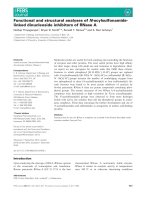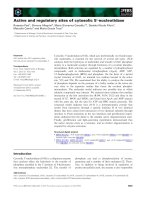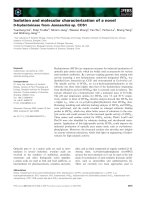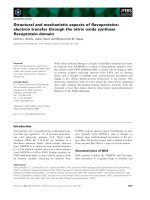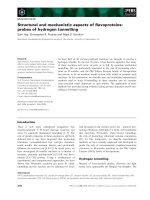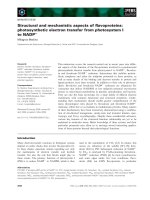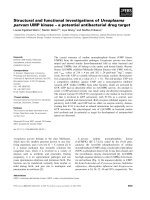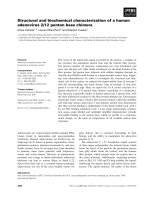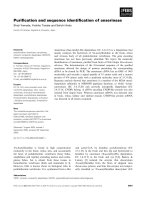Báo cáo khoa học: Anti- and pro-oxidant effects of quercetin in copper-induced low density lipoprotein oxidation Quercetin as an effective antioxidant against pro-oxidant effects of urate potx
Bạn đang xem bản rút gọn của tài liệu. Xem và tải ngay bản đầy đủ của tài liệu tại đây (444.55 KB, 9 trang )
Anti- and pro-oxidant effects of quercetin in copper-induced low
density lipoprotein oxidation
Quercetin as an effective antioxidant against pro-oxidant effects of urate
Paulo Filipe
1,2
, Josiane Haigle
3
, Joa
˜
o Nuno Silva
1,2
, Joa
˜
o Freitas
1,2
, Afonso Fernandes
1
,
Jean-Claude Mazie
`
re
4
,Ce
´
cile Mazie
`
re
4
, Rene
´
Santus
3,5
and Patrice Morlie
`
re
3,5
1
Centro de Metabolismo e Endocrinologia and
2
Clinı
´
ca Dermatolo
´
gica Universita
´
ria, Faculdade de Medicina de Lisboa, Hospital de
Santa Maria, Lisbon, Portugal;
3
Muse
´
um National d’Histoire Naturelle, RDDM, Photobiologie – INSERM U.532, Paris, France;
4
Laboratoire de Biochimie, Universite
´
de Picardie Jules Verne, U Amiens, Ho
ˆ
pital Nord, Amiens, France;
5
Institut de Recherche sur
la Peau, INSERM U.532, Ho
ˆ
pital Saint-Louis, Paris, France
We recently reported that, depending on its concentration,
urate is either a pro- or an antioxidant in Cu
2+
-induced low-
density lipoprotein (LDL) oxidation. We also previously
demonstrated an antioxidant synergy between urate and
some flavonoids in the Cu
2+
-induced oxidation of diluted
serum. As a result, the effect of the flavonoid quercetin on the
Cu
2+
-induced oxidation of isolated LDL has been studied
either in the presence or absence of urate. We demonstrate
that, like urate, quercetin alone, at low concentration,
exhibits a pro-oxidant activity. The pro-oxidant behavior
depends on the Cu
2+
concentration but it is not observed at
high Cu
2+
concentration. When compared with urate, the
switch between the pro- and the antioxidant activities occurs
at much lower quercetin concentrations. As for urate, the
pro-oxidant character of quercetin is related to its ability to
reduce Cu
2+
with the formation of semioxidized quercetin
and Cu
+
with an expected yield larger than that obtained
with urate owing to a more favorable redox potential. It is
also shown that the pro-oxidant activity of urate can be
inhibited by quercetin. An electron transfer between
quercetin and semioxidized urate leading to the repair of
urate could account for this observation as suggested by
recently published pulse radiolysis data. It is anticipated that
the interactions between quercetin–Cu
2+
–LDL and urate,
which are tightly controlled by their respective concentra-
tion, determine the balance between the pro- and antioxidant
behaviors. Moreover, as already observed with other anti-
oxidants, it is demonstrated that quercetin alone behaves as a
pro-oxidant towards preoxidized LDL.
Keywords: antioxidant; copper; flavonoid; low-density lipo-
protein; oxidative stress; pro-oxidant; urate.
It is generally accepted that diets rich in fruit and vegetables
protect against cardiovascular diseases [1,2], certain types of
cancer [3], and perhaps against other pathological condi-
tions. This protection has been attributed to the anti-
oxidants present in plants including various phenolic
compounds such as flavonoids. The biological, preventive,
and therapeutic properties of flavonoids have been exten-
sively studied. It has recently been shown that some
flavonoids can cross the intestinal barrier into the blood-
stream [4,5]. However, detected levels are extremely low in
relation to the ingested amounts.
Low-density lipoprotein (LDL) oxidative modification is
currently thought to be a key process in the atherogenesis
[6–9]. The in vitro inhibitory effects of flavonoids on LDL
peroxidation induced by copper(II) ions, azo derivatives
and macrophages are well established. The radical scaven-
ging properties of phenolic compounds depend on their
redox potentials [10–12]. In addition, the antioxidant action
is related to their ability to chelate transition metal ions
[13–16]. The flavonoid antioxidant efficacy in biological
systems also depends on the partition coefficient between
the lipophilic and the aqueous phases [17,18], the binding
to macromolecules [19,20], and the interaction with other
antioxidants [21–28].
In most reports, the concentration of phenolic com-
pounds to produce half of the maximum inhibition lies in
the 1–10 l
M
range. With the exception of ascorbate, the
antioxidant synergy between flavonoids and other extra-
cellular antioxidants has not been fully explored. The
interaction of flavonoids with ascorbate was first des-
cribed in 1936 [29,30], when it was found that the extracts
of Hungarian red pepper contained an ascorbate-protect-
ive factor, named vitamin P. Later on, this factor was
identified as a mixture of flavonoids, and its effect was
interpreted as the result of the antioxidant action of these
compounds.
Correspondence to P. Morlie
`
re, Muse
´
um National d’Histoire
Naturelle, RDDM, Photobiologie – INSERM U.532,
Case Postale 26, 43 rue Cuvier, 75231 Paris cedex 05, France.
Fax: + 33 1 40793716, Tel.: + 33 1 40793884,
E-mail:
Abbreviations: LDL, low-density lipoprotein; LPO, lipid peroxidation;
MDA, malondialdehyde; MM-LDL, minimally modified low-density
lipoprotein; SOD, superoxide dismutase; TBARS, thiobarbituric
acid-reactive substances.
(Received 30 December 2003, revised 3 March 2004,
accepted 25 March 2004)
Eur. J. Biochem. 271, 1991–1999 (2004) Ó FEBS 2004 doi:10.1111/j.1432-1033.2004.04111.x
It is well known that urate, one of the most important
plasma antioxidants resulting from the breakdown of
purines, inhibits LDL peroxidation [31]. The mechanisms
of this effect include the ability of urate to scavenge reactive
oxygen and nitrogen species, and to chelate catalytic metal
ions [32–34] (reviewed in [35]). However, data are lacking
on the interaction of urate with other antioxidants. As a
consequence we have investigated the effect of dietary
flavonoids, associated or not with urate, on the oxidation of
human LDL induced by copper(II) ions. This investigation
appears sensible as it was recently demonstrated [36] that,
at low concentration, urate may behave as a pro-oxidant.
Moreover, in an earlier report it was suggested that
flavonoids and urate could act in synergy to protect plasma
lipoproteins against the oxidative stress [37]. The main goal
of this work was therefore to evaluate whether and how
urate and flavonoids interact during the Cu
2+
-induced
LDL oxidation. Because of its largely recognized anti-
oxidative properties, quercetin was chosen as a model
flavonoid in this study.
Materials and methods
Materials, solvents and routine equipment
Quercetin dihydrate and sodium urate were obtained from
Sigma Chemical Co. (Saint-Louis, MO, USA). The high-
performance liquid chromatography (HPLC) columns were
supplied by Merck (Darmstadt, Germany) and HPLC
grade solvents were purchased from Carlo Erba (Val de
Reuil, France). All other chemicals were of the highest
purity available from Sigma or Merck companies.
Preparation and treatment of LDL
Serum samples were obtained from healthy volunteers.
LDL (d ¼ 1.024–1.050) were prepared by sequential ultra-
centrifugation according to Havel et al. [38] and dialyzed
against pH 7.4, 5 m
M
Tris buffer containing 50 m
M
NaCl
and 0.02% EDTA. Protein determination was carried out
by the technique of Peterson [39]. Unless specifically stated
in the text, these LDL preparations were used within
2–3 weeks. Just before experiments, LDL were dialyzed
twice for 8 and then 16 h against 1 L of pH 7.4, 10 m
M
phosphate buffer to remove ETDA. Then, LDL were
diluted to a final concentration of 0.15 mgÆmL
)1
(300 n
M
).
To 800 lL of these LDL solutions, were added 50 lLofa
stock solution of urate in pH 7.4, 10 m
M
phosphate buffer
and/or 10 lL of a stock solution of the studied flavonoid in
pH 7.4, 10 m
M
phosphate buffer or ethanol. LDL solutions
without urate and/or flavonoid but containing matching
solvent volumes were similarly prepared. Then, all these
LDL solutions were diluted to a final volume of 950 lL
with phosphate buffer and were incubated at 37 °Cfor
15 min. Lipid peroxidation (LPO) was triggered by adding
50 lLofaCuCl
2
solution in pH 7.4, 10 m
M
phosphate
buffer preheated at 37 °C to obtain a final concentration of
Cu
2+
of 5 or 175 l
M
.AfterCu
2+
addition, the formation of
conjugated dienes and malondialdehyde (MDA) and the
consumption of urate and carotenoids were measured, as
described below, either after a 1 h incubation at 37 °Corat
various times during incubation.
Conjugated diene determination
Conjugated diene formation was monitored by second
derivative spectroscopy (220–300 nm) based on an earlier
described methodology [40]. In short, 80 lLofthesample
were diluted 10-fold with pH 7.4, 10 m
M
phosphate
buffer before spectrum recording. The second derivative
spectrum was subtracted from the second derivative
spectrum of the matching control sample without cop-
per(II). The increase in conjugated dienes expressed in
relative unit was obtained from the amplitude of the
254 nm peak.
Malondialdehyde measurement
The simultaneous determination of free MDA and urate
was performed by HPLC using a LiChrospher100 NH
2
column [41]. After incubation, solutions were mixed with
an equal volume of acetonitrile, centrifuged at 12 000 g for
5 min and frozen at )80 °C until HPLC measurement. The
supernatants were isocratically eluted during 25 min with a
mobile phase consisting of pH 7.4, 54 m
M
Tris-HCI and
acetonitrile (30 : 70, v/v). The flow rate was 1.0 mLÆmin
)1
and the absorption was monitored at 270 nm. The MDA
peak was identified by comparison with a reference
chromatogram of free MDA, freshly prepared by
acid hydrolysis of 1,1,3,3-tetraethoxypropane stock
solution. The MDA concentration of this standard
solution was determined assuming a molar absorbance of
13 700
M
)1
Æcm
)1
at 245 nm. This solution was then diluted
with pH 7.4, 54 m
M
Tris-HCI buffer to obtain MDA
concentrations in the 1–10 l
M
range and then, mixed with
acetonitrile (1 : 1, v/v) before HPLC.
Consumption of carotenoids
The basal carotenoid content of LDL preparations was
spectrophotometrically determined after extraction [42].
To this end, 0.25 mL of water, 1 mL of ethanol and
2 mL of hexane were added to 0.25 mL of LDL. The
hexane upper phase (2 mL) was collected and the visible
absorption spectrum (350–600 nm) was recorded. The
concentration of total carotenoids was determined using
an average extinction coefficient of 140 000
M
)1
Æcm
)1
at
448 nm based on a calculation from the four main
carotenoids in human plasma, a-carotene, b-carotene,
b-cryptoxanthin and lycopene [43,44]. Change in caro-
tenoid concentration during LDL oxidative treatment
was monitored by second derivative absorption spectros-
copy (400–550 nm) through the measure of the amplitude
of the second derivative spectrum between 489 and
516 nm.
Urate consumption
As mentioned above, urate was determined by HPLC,
simultaneously with MDA. The urate peak in chromato-
grams was identified by comparison with reference chro-
matograms of freshly prepared standard urate solutions in
the 1–20 l
M
range. The concentration of urate in the
samples was calculated from the peak area compared to that
of standard solutions.
1992 P. Filipe et al. (Eur. J. Biochem. 271) Ó FEBS 2004
Results
MDA production as a function of the quercetin
concentration
After incubation for 15 min at 37 °C with various concen-
trations of quercetin, LDLs were exposed to 175 l
M
or
5 l
M
CuCl
2
. One hour after Cu
2+
addition, the extent of
LPO was estimated from MDA measurements as shown in
Fig. 1. At high Cu
2+
concentration (175 l
M
),theMDA
production decreases with increasing quercetin concentra-
tion (Fig. 1A). It is worth noting that quercetin concentra-
tions as low as 0.5 l
M
already significantly decreases the
MDA production. At low Cu
2+
concentration (5 l
M
)a
pro-oxidant effect is observed at low quercetin concentra-
tions (< 2 l
M
) whereas quercetin becomes antioxidant at
higher concentration (‡ 2 l
M
). The switch between the pro-
and antioxidant activities occurs at 1.5 l
M
of quercetin.
These experiments were also performed in the presence of
urate. They were carried out as described above, except that
LDL were simultaneously incubated with various concen-
trations of quercetin and 10 l
M
urate prior to Cu
2+
addition. As can be seen in Fig. 1, urate alone at 10 l
M
is
pro-oxidant, with an amplification of about 200% at high
Cu
2+
concentration (175 l
M
) and about 600% at low Cu
2+
concentration (5 l
M
) in agreement with reference [36]. At
high Cu
2+
concentration and concentrations of quercetin as
low as 0.5 l
M
, the production of MDA drops to negligible
values much lower than those obtained in the absence
of both urate and quercetin. At low Cu
2+
concentration,
quercetin also decreases the MDA level but the full
inhibition requires larger concentrations than those needed
at high Cu
2+
concentration. Interestingly, we may note that
the pro-oxidant effect observed with low concentrations of
quercetin alone did not add to the pro-oxidant effect of
10 l
M
urate. On the contrary, such low concentrations
lowered the MDA production. For example, 0.75 l
M
quercetin or 10 l
M
urate alone enhances the MDA
production by factors of about 250 and 600%, respectively.
When added together they significantly decrease the MDA
level to 60%. Data profiles similar to those shown in Fig. 1
were obtained when LPO was estimated by the production
of thiobarbituric reactive substances or conjugated dienes
(data not shown).
Time courses of MDA and conjugated diene formation
The data presented in Fig. 1 have been obtained at a
constant time (1 h) after the addition of Cu
2+
. Kinetic
analyses may prove to be helpful in understanding the
effects observed under Ôstatic conditionsÕ. Our attention
has been focused on the effect of low concentrations
of quercetin. Depending on the Cu
2+
concentration this
flavonoid may be pro-oxidant in the absence of urate or
may inhibit the pro-oxidant effect of urate. The Cu
2+
-
induced LPO in LDL was evaluated by monitoring the
formation of MDA (Fig. 2A,C) and of conjugated dienes
(Fig. 2B,D) in the presence and absence of 10 l
M
urate at
high (175 l
M
) (Fig. 2A,B) and low (5 l
M
) (Fig. 2C,D)
Cu
2+
concentrations. With regard to the MDA formation
at high Cu
2+
concentration, Fig. 2A fully confirms the pro-
oxidant activity of low urate concentrations with enhanced
MDA formation and the moderate protection brought by
0.5 l
M
quercetin at short times after Cu
2+
addition. In the
presence of both urate and quercetin, the MDA formation is
strongly slowed down and occurs about 90 min after Cu
2+
addition. Similar effects are observed with the formation of
conjugated dienes (Fig. 2B). Thus, the time course of their
formation (Fig. 2B,D) exhibits the classical shape charac-
terized by a lag time followed by a linear increase until a
maximum is reached. Then they slowly decay [45]. When
separately added, 10 l
M
urate decreases the lag-time
whereas 0.5 l
M
quercetin slightly increases it. On the other
hand, when simultaneously added, quercetin and urate have
a strong antioxidant activity with a lag-time for conjugated
diene formation lasting for about 2 h.
At low Cu
2+
concentration, the kinetic data in Fig. 2C
are in agreement with those obtained under Ôstatic condi-
tionsÕ in Fig. 1A; that is to say 10 l
M
urate strongly
enhances MDA production whereas 0.5 l
M
quercetin also
increases it but to a lesser extent. Higher quercetin
concentrations, namely 2 l
M
, inhibit the MDA formation
Fig. 1. Effect of quercetin on LDL oxidation induced by 175 l
M
(A) or 5 l
M
Cu
2+
(B) in the absence or in the presence of 10 l
M
urate. In (A) and (B),
LDL at 0.12 mgÆmL
)1
(240 n
M
) in pH 7.4, 10 m
M
phosphate buffer were incubated for 15 min at 37 °C with various concentrations of quercetin,
with or without urate. Then, 175 l
M
(A) or 5 l
M
(B) of CuCl
2
were added and the mixture was further incubated at 37 °Cfor1hbeforeMDA
assay. In (A) and (B), controls in the absence of Cu
2+
yielded non-detectable or negligible levels of MDA (data not shown). Data were normalized
to those obtained in the absence of quercetin and urate (taken as 100%) and are the mean ± SD of at least three experiments performed with
independent LDL preparations.
Ó FEBS 2004 Flavonoids and urate in copper-induced low-density lipoprotein oxidation (Eur. J. Biochem. 271) 1993
up to about 2 h. Finally, as shown in Fig. 2(C), slightly
pro-oxidant concentrations of quercetin (0.5 l
M
) protect
from the pro-oxidant effect of 10 l
M
urate. Larger
quercetin concentrations (e.g. 2 l
M
) completely inhibit the
pro-oxidant effect of 10 l
M
urate as no MDA is formed
during 3 h.
The same conclusions can be drawn with regard to the
formation of conjugated dienes at low Cu
2+
concentrations
(Fig. 2D). Again, when separately added, 10 l
M
urate
shortens the lag time, in agreement with a pro-oxidant
behavior whereas 0.5 l
M
quercetin exhibits a moderate pro-
oxidant behavior. When added together 0.5 l
M
quercetin
partly inhibits the pro-oxidant effect of 10 l
M
urate. At
higher concentration (2 l
M
), quercetin strongly delays the
appearance of the propagation phase when alone but
completely abolishes the pro-oxidant effect of 10 l
M
urate.
Time courses of carotenoids and urate consumption
The consumption of carotenoids was measured as an index
of the overall consumption of the endogenous antioxidants
of LDL during their Cu
2+
-induced oxidation. As shown in
Fig. 3(A,C), carotenoids are consumed in parallel to MDA
and conjugated diene formation. As already reported [36],
at low Cu
2+
concentration, 10 l
M
urate accelerates the
carotenoid consumption (Fig. 3C). At high Cu
2+
concen-
tration, the consumption of carotenoids is practically
unchanged by the presence of this pro-oxidant concentra-
tion of urate (Fig. 3A). As observed with the formation of
conjugated dienes (Fig. 2B) or of MDA (Fig. 1A), 0.5 l
M
quercetin behaves as an antioxidant and induces a delay
in the carotenoid consumption (Fig. 3A).
At low Cu
2+
concentration, 0.5 l
M
quercetin becomes
pro-oxidant with enhanced formation of MDA and conju-
gated diene, as presented above. Accordingly no delay in the
carotenoid consumption is observed (Fig. 3C). However,
the protective effect of quercetin is recovered at higher
concentrations, namely 2 l
M
(Fig. 3C). In the presence of a
pro-oxidant concentration of urate (e.g. 10 l
M
),0.5l
M
quercetin, which is pro-oxidant in the absence of urate,
markedly slows down the carotenoid consumption
(Fig. 3C). Increasing the quercetin concentration to 2 l
M
leads to strong protection of the carotenoids, this protection
being even better than with quercetin alone (Fig. 3C).
Interestingly, at this low Cu
2+
concentration, urate, which
is rapidly consumed when added alone, is slightly protected
by 0.5 l
M
quercetin and fully protected by 2 l
M
quercetin
(Fig. 3D). At high Cu
2+
concentration, 0.5 l
M
quercetin
delays the carotenoid consumption more efficiently that
quercetin alone (Fig. 3A) and also protects urate (Fig. 3B).
Effect of quercetin on the copper-induced lipid
peroxidation in preoxidized LDL
In order to evaluate the effect of quercetin on the Cu
2+
-
induced LPO in pre-oxidized LDL, LDL were first incuba-
tedwithCu
2+
and then quercetin was added after LPO
started. Quercetin concentrations were chosen such as
Fig. 2. Kinetic profiles of MDA (A,C) and conjugated diene (B,D) formation in LDL oxidation induced by 175 l
M
(A,B) or 5 l
M
(C,D) Cu
2+
. LDL at
0.12 mgÆmL
)1
(240 n
M
) in pH 7.4, 10 m
M
phosphate buffer was incubated for 15 min at 37 °C with or without quercetin, and with or without
10 l
M
urate. Then, 175 l
M
or 5 l
M
of CuCl
2
were added and the mixture was further incubated at 37 °C. MDA: Conjugated dienes were measured
at various intervals after Cu
2+
addition. Note that time zero corresponds to the shortest time after addition of Cu
2+
inallsamples,e.g.1min.
Control experiments in the absence of Cu
2+
yielded non detectable or negligible levels of MDA and of conjugated dienes (data not shown). Data
are the mean ± SD of at least three experiments performed with independent LDL preparations.
1994 P. Filipe et al. (Eur. J. Biochem. 271) Ó FEBS 2004
quercetin behaves as an antioxidant in un-oxidized LDL,
i.e. 0.75 l
M
and 2 l
M
for high and low Cu
2+
concentra-
tions, respectively. By contrast, when quercetin is added
30 min after the oxidation started, LPO was higher than
that obtained in the absence of quercetin (Fig. 4). In other
words, under these conditions quercetin becomes pro-
oxidant. As a second model of slightly preoxidized LDL, we
used LDLs that were kept in the dark at 4 °C in the presence
of EDTA for 5–8 weeks. Such conditions are described in
the literature as yielding the so-called minimally modified
LDL (MM-LDL) [46,47]. As can be seen in Table 1, in the
presence of quercetin, lag times for conjugated diene
formation are shorter than those measured in its absence.
In addition, quercetin accelerates the consumption of
carotenoids in MM-LDL treated with Cu
2+
(Table 1).
This definitely means that under these conditions quercetin
is no longer an antioxidant but behaves as a pro-oxidant.
Discussion
Over the 15 past years, the oxidation of LDL has been
widely studied in order to understand better the role of LDL
oxidation in vivo in pathological situations, such as ather-
ogenesis [6–9]. For this purpose, in vitro models have been
developed including the oxidation of LDL by Cu
2+
to
which much attention has been paid [48]. However, the
exact mechanisms relating Cu
2+
redox change to the LPO
in LDL are not yet clearly established [49]. In the presence of
pre-existing traces of hydroperoxides (LOOH), Cu
2+
and
Cu
+
may be either reduced or oxidized, generating
hydroperoxyl (LOO
•
) or alkoxyl (LO
•
) radicals that in turn
can trigger the LPO propagation phase. It is currently
admitted that Cu
2+
reduction to Cu
+
is required for
triggering LPO in LDL [50], but the exact nature of the
Fig. 3. Kinetic profiles of carotenoid (A,C) and urate (B,D) consumption in LDL oxidation induced by 175 l
M
(A,B) or 5 l
M
(C,D) Cu
2+
. Experi-
mental conditions are those of Fig. 2. Urate and carotenoids were measured at various intervals after Cu
2+
addition. Control experiments in the
absence of Cu
2+
(·), yielded no significant loss of carotenoids or urate. Note that time zero in (B) and (D) corresponds to the shortest time after
addition of Cu
2+
in all samples, e.g. 1 min. Data are expressed as a percentage of the value obtained before Cu
2+
addition and are the mean ± SD
of at least three experiments performed with independent LDL preparations.
Fig. 4. Effect of quercetin on Cu
2+
-induced LDL oxidation in preoxi-
dized LDL. CuCl
2
(175 or 5 l
M
) was added to LDL solutions at
0.12 mgÆmL
)1
(240 n
M
) in pH 7.4, 10 m
M
phosphate buffer preheated
for 15 min at 37 °C, and the mixture was further incubated at 37 °C
for 1 h before MDA assay. Quercetin was added either 15 min before
Cu
2+
addition or 30 min after Cu
2+
addition. Quercetin concentra-
tionswere0.75or2 l
M
for Cu
2+
concentrations equal to 175 or 5 l
M
,
respectively (see text). Data were normalized to those obtained in the
absence of quercetin (taken as 100%) and are the mean ± SD of at
three experiments performed with independent LDL preparations.
Ó FEBS 2004 Flavonoids and urate in copper-induced low-density lipoprotein oxidation (Eur. J. Biochem. 271) 1995
involved reductants in LDL, such as pre-existing LOOH,
tryptophan residues or even a-tocopherol, is still questioned
[51–59]. Their progressive involvement has been suggested
by Perugini et al. [57]. It has also been suggested but never
demonstrated that
•
O
2
–
, generated by Cu
2+
oxidation may
be involved [60].
Our main goal was to investigate the interplay between
urate and flavonoids in the Cu
2+
-induced oxidation of
LDL. Such a work was undertaken because we recently
reported, in mimicking oxidative stress in diluted plasma
[37], that flavonoids could act in synergy with urate, one
of the major plasma antioxidant. Antioxidant properties of
flavonoids have been widely studied within the last 20 past
years. A peculiar attention has been paid to the antioxidant
effect of flavonoids towards the oxidation of LDL whose
oxidative modification is thought to be a key process in
atherogenesis. The antioxidant protection conferred by
phenolic compounds is believed to be caused by a combi-
nation of their binding to critical sites on LDL, their metal
chelation properties and their free radical scavenging
activities. Their overall antioxidant efficacy in biological
systems also depends on their partition between lipophilic
and aqueous phases, their binding to other biomolecules
and their interaction with other antioxidants. Quercetin was
chosen as a representative flavonoid in this study as it is
rather universally found in plants and it has been the subject
of numerous studies. As a result, we first characterized its
antioxidant properties in our LDL oxidation model. It must
be pointed out that besides the commonly used low Cu
2+
concentration (5 l
M
here), we also performed experiments
with a physiologically unrealistic high Cu
2+
concentration
(175 l
M
). Such a high Cu
2+
concentration was used to
overcome the chelating ability of quercetin. Moreover the
use of both low and high Cu
2+
concentrations allows
discussing the present data in the light of our earlier reports
[36,37]. It must be underlined that the quercetin concentra-
tions that were used here (0.25–2 l
M
) are biologically
realistic. Indeed, it has been shown that the concentration of
quercetin derivatives in plasma reached about 0.4 [4], 0.6 [5]
and 0.8 l
M
[61], 2–3 h after the ingestion of a quercetin-rich
meal (about 50–90 mg of ingested quercetin). These values
are about an order of magnitude higher than the baseline
concentration.
In addition to their well established antioxidant proper-
ties, flavonoids, as several other antioxidants, to be pro-
oxidant under certain circumstances. In the Cu
2+
-induced
LDL oxidation model, catechins [62] and a flavonoid
extract [63] share this pro-oxidant ability with caffeic acid
[64], ascorbate [63] or urate [36,65,66]. This pro-oxidant
behavior was described when the antioxidant is added
at various times after LPO started, i.e. when some lipid
peroxides are already formed. Accordingly, this pro-oxidant
behavior is also encountered in Cu
2+
-induced oxidation of
slightly oxidized LDL. We observed that quercetin also
exhibits this pro-oxidant capacity. Indeed, the production of
an exacerbated amount of MDA (Fig. 4) demonstrates that
quercetin is antioxidant when present before LPO started
but becomes pro-oxidant when introduced 30 min after
addition of Cu
2+
. It is also illustrated in Table 1 reporting
that, as opposed to native LDL, quercetin accelerates the
formation of conjugated dienes (shortened lag time) and the
consumption of endogenous carotenoids (shortened half
time) in MM–LDL. It is accepted that this pro-oxidant
behavior is related to the availability of hydroperoxides and
that ÔantioxidantsÕ promote LPO by increasing the concen-
tration of catalytic Cu
+
because of their ability to reduce
Cu
2+
.
More importantly, our data demonstrate that a pro-
oxidant behavior of quercetin can be observed in the
absence of pre-existing hydroperoxides, i.e. working with
native LDL with quercetin present before LPO started. The
presence of abnormally high levels of hydroperoxides in our
LDL preparations, that could explain the data reported
above, has been ruled out as discussed in [36,] This is
observed at low Cu
2+
concentration and it is illustrated on
Figs 1 and 2C in terms of MDA production and on Fig. 2D
in terms of conjugated diene formation. Interestingly, this
pro-oxidant behavior is observed at low concentration of
ÔantioxidantÕ. In view of the MDA formation profile on
Fig. 1, the switch from the pro-oxidant behavior to the
classical antioxidant properties occurs with 1–2 l
M
querce-
tin. This is confirmed with the conjugated diene formation,
which is slightly promoted by 0.5 l
M
quercetin but strongly
abolished by 2 l
M
quercetin (Fig. 2D). As to the consump-
tion of endogenous carotenoids, the pro-oxidant behavior is
still possibly observed at low quercetin concentration
(0.5 l
M
) while 2 l
M
quercetin definitely induces a strong
protective effect. We recently reported such a behavior with
another well-known physiological antioxidant, e.g. urate
[36]. We suggested that this pro-oxidant behavior was
related to the ability of urate to reduce Cu
2+
, leading to
•
UH
–
and Cu
+
. We brought evidence that, at high Cu
2+
concentration,
•
O
2
–
was involved probably formed by the
oxidation of Cu
+
by O
2
. We suggested that the concomitant
formation of
•
UH
–
and
•
O
2
–
could allow a reaction between
these species, thus leading to some kind of
•
O
2
–
activation.
Table 1. Effect of quercetin on the lag time for conjugated diene formation and on the half time for carotenoid consumption in Cu
2+
-treated MM-LDL.
Data in parentheses correspond to those obtained with native LDL. Detailed experimental conditions are those of Figs 2 and 3. Quercetin
concentrations were 0.75 and 2 l
M
for Cu
2+
equal to 175 and 5 l
M
, respectively. Lag times before conjugated diene formation were estimated as
the intercept of the linear part of the kinetics of diene formation shown in Fig. 2(B,D) with x-axis. Half times for carotenoid consumption were
obtained from the kinetic of carotenoid consumption shown in Fig. 3(A,C).
Conditions
Lag time (min) Half time (min)
Cu
2+
¼ 175 l
M
Cu
2+
¼ 5 l
M
Cu
2+
¼ 175 l
M
Cu
2+
¼ 5 l
M
Without quercetin 5( 24) 17 ( 33) 18 ( 27) 24 ( 45)
With quercetin ( 39)
a
6 (> 120) 14 ( 50) 12 (> 150)
a
Too short to be measured.
1996 P. Filipe et al. (Eur. J. Biochem. 271) Ó FEBS 2004
At low Cu
2+
concentration, the exact mechanism was not
elucidated, but an
•
O
2
–
-independent mechanism was pro-
posed, still involving the reduction of Cu
2+
by urate. This
intriguing behavior has to be related to complex urate–
Cu
2+
–LDL interactions, which are governed by their
respective concentrations. In the view of the analogous
behaviors observed here with quercetin and previously with
urate, it may be hypothesized that similar mechanisms are
involved. We already provided evidence that quercetin was
able to reduce Cu
2+
[37]. When comparing the present data
with those obtained with urate, it is interesting to note that
at low Cu
2+
concentration the switch between the pro-
oxidant and antioxidant behavior occurs at about 1 l
M
with
quercetin and 200 l
M
with urate [36]. As we pointed out in
our earlier report dealing with urate, the pro-oxidant
mechanism observed at low concentration is still operative
at high concentration but is no longer observed because, at
high concentration, the antioxidant activity (chelation,
radical scavenging) prevails. Thus, the lower concentration
for switching between pro- and antioxidant properties for
quercetin as compared to urate may reflect the better overall
antioxidant activity of quercetin. Conversely, it may also
reflect a pro-oxidant ability larger for quercetin than for
urate, thus requiring lower concentrations to be observable.
As a matter of fact, at pH 7, the standard redox potential of
the couple
•
QH
–
,H
+
/QH
2
–
(0.33 vs. NHE [12,67]) is higher
than that of the couple
•
UH
–
,H
+
/UH
2
–
(0.59 vs. NHE [34]).
The reduction of Cu
2+
to Cu
+
(E° ¼ 0.167 vs. NHE) is
thermodynamically unfavorable but less unfavorable for
quercetin than for urate. Thus the production of equal
amounts of catalytic Cu
+
from urate or quercetin will
require lower quercetin concentrations.
Finally, as mentioned in the introduction, we studied
the interaction of urate and quercetin in the Cu
2+
-induced
LDL oxidation model. As stated above, urate at moder-
ately low concentrations behaves as a pro-oxidant at low
and high Cu
2+
concentrations. This is illustrated with
10 l
M
urate in Figs 1 and 2(B,C) showing an overpro-
duction of MDA. It is also clearly shown with an
accelerated conjugated diene formation (Fig. 2B,D) and
carotenoid consumption especially at low Cu
2+
concen-
tration (Fig. 3C). At high Cu
2+
concentration, the addi-
tion of 0.5 l
M
quercetin, which, alone, is moderately
antioxidant, not only inhibits the pro-oxidant effect of
urate, but exerts an overall protective effect on the LDL
oxidation larger than that obtained with quercetin alone.
Under these conditions, the urate destruction is slowed
down by the presence of quercetin (Fig. 3C). At low Cu
2+
concentration, a somewhat similar behavior is observed.
Thus, 0.5 l
M
quercetin which, in this case, is pro-oxidant
when alone, partly inhibits the pro-oxidant action of urate
(Figs 1B, 2C,D and 3C). Larger quercetin concentrations,
namely 2 l
M
, completely inhibit the pro-oxidant action of
urate leading to full overall protection. It is interesting to
mention that 2 l
M
quercetin inhibits the urate consump-
tion up to 3 h after Cu
2+
addition (Fig. 3D). This
powerful antioxidant interaction of quercetin and urate
can be partially explained by the interception of reactive
species, chelation of transition metal ions and/or regener-
ation of urate from its radical form. The recycling of urate
is possible as at pH 7, the redox potential of the
•
UH
–
,
H
+
/UH
2
–
couple (0.59 V vs. NHE) is higher than that of
the
•
QH
–
,H
+
/QH
2
–
couple (0.33 V vs. NHE) [12,34,67]
and allows the reaction of quercetin with
•
UH
–
.Using
pulse radiolysis, we recently provided good evidence for
this reaction [68]. We showed, upon addition of quercetin,
an increase in the decay rate of the transient absorption of
•
UH
–
accompanied by a growth of the transient absorp-
tion of the semireduced quercetin (
•
QH
–
) demonstrating
the regeneration of urate by quercetin. At high Cu
2+
concentration, where
•
O
2
–
is believed to be involved in the
pro-oxidant action of urate [37], the reaction of
•
UH
–
with
quercetin competes with its reaction with
•
O
2
–
and impedes
the pro-oxidant activity of urate to occur. At low Cu
2+
concentration, another unidentified mechanism was sug-
gested where
•
O
2
–
is not involved, but where Cu
+
is
necessary [37]. As a consequence of the reaction of
quercetin with
•
UH
–
, it turns out that
•
UH
–
wouldalsobe
involved in the pro-oxidant action of urate. Interestingly,
at high Cu
2+
concentration, in the presence of 0.5 l
M
quercetin and 10 l
M
urate, the LDL oxidation measured
in terms of MDA and conjugated diene formation drops
to a level below that observed in the absence of urate
(Figs 1A and 2A,B). The same concept applies to the
carotenoid consumption shown in Fig. 3A. Though we
have no definite interpretation for such an observation, we
may suppose that in the absence of quercetin the pro-
oxidant activity of urate masks its antioxidant activity as
mentioned above, whereas, in the presence of quercetin,
the pro-oxidant activity of urate disappears and its
antioxidant activity is revealed.
Conclusions
The results presented here on the Cu
2+
-induced oxida-
tion of LDL show that quercetin, as other oxidants, can
be pro-oxidant towards slightly oxidized LDL and, at
low concentration, can behave like urate as a pro-oxidant
towards native LDL. This study also demonstrates that
quercetin at low and pro-oxidant concentrations is no
longer pro-oxidant in the presence of pro-oxidant urate
concentrations. Under these conditions, it even protects
against the pro-oxidant activity of urate. As to the
mechanism, it is suggested that quercetin, because of its
appropriate redox potential can regenerate urate by
reducing the
•
UH
–
radical. Accordingly, quercetin inhibits
the pro-oxidant activity of urate associated with the
presence of the
•
UH
–
radical. However, some points still
remain un-understandable. Indeed, during the
•
UH
–
repair,
•
QH
–
would be generated, which may be associ-
ated with the pro-oxidant activity of quercetin at low
concentration. It is quite obvious that a detailed know-
ledge of these mechanisms deserves further investigations.
It may be anticipated that the intricate relationship
between antioxidant and pro-oxidant action of antioxi-
dants, such as quercetin or urate, is closely related to the
spatial and temporal interactions of the various actors, as
emphasized by our recent study on the repair of
semioxidized urate by quercetin bound to HSA [69]. In
other words, the interactions between quercetin, Cu
2+
,
LDL, and urate when present, which are closely
controlled by their respective concentrations, may be
determinant in the balance between the pro- and
antioxidant behaviors.
Ó FEBS 2004 Flavonoids and urate in copper-induced low-density lipoprotein oxidation (Eur. J. Biochem. 271) 1997
Acknowledgements
This work was partly supported by an exchange grant from INSERM
and GRICES. C. M. and J C. M. thank the ÔUniversite
´
de Picardie
Jules VerneÕ and the ÔMiniste
`
re de la Recherche et de la TechnologieÕ for
financial support.
References
1. Hertog, M.G., Feskens, E.J., Hollman, P.C., Katan, M.B. &
Kromhout, D. (1993) Dietary antioxidant flavonoids and risk of
coronary heart disease: the Zutphen Elderly Study. Lancet 342,
1007–1011.
2. Knekt, P., Jarvinen, R., Reunanen, A. & Maatela, J. (1996) Fla-
vonoid intake and coronary mortality in Finland: a cohort study.
Br.Med.J.312, 478–481.
3. Kuo, S M. (1997) Dietary flavonoid and cancer prevention: evi-
sence and potential mechanism. Crit.Rev.Oncog.8, 47–69.
4. Manach, C., Morand, C., Crespy, V., Demigne
´
,C.,Texier,
Re
´
ge
´
rat, F. & Re
´
me
´
sy, C. (1998) Quercetin is recovered in human
plasma as conjugated derivatives which retain antioxidant prop-
erties. FEBS Lett. 426, 331–336.
5. Hollman, P.C.H., Gaag, M.V.D., Mengelers, M.J.B., van Trijp,
J.M.P., de Vries, J.H.M. & Katan, M.B. (1996) Absorption and
disposition kinetics of the dietary antioxidant quercetin in man.
Free Radic. Biol. Med. 21, 703–707.
6. Parthasarathy,S.,Printz,D.J.,Bloyd,D.,Joy,L.&Steinberg,D.
(1986) Macrophage oxidation of low density lipoprotein generates
a modified form recognized by the scavenger receptor. Arterio-
sclerosis 6, 505–510.
7. Steinbrecher, U.P., Lougheed, M., Kwan, W.C. & Dirks, M.
(1989) Recognition of oxidized low density lipoprotein by the
scavenger receptor of macrophages results from derivatization of
apolipoprotein B by products of fatty acid peroxidation. J. Biol.
Chem. 264, 15216–15223.
8. Steinberg, D., Parthasarathy, S., Caew, T.E., Khoo, J.C. & Wit-
zum, J.L. (1989) Beyond cholesterol: modifications of low-density
lipoprotein that increase its atherogenicity. N.Engl.J.Med.320,
915–924.
9. Witzum, J.L. (1994) The oxidation hypothesis of atherosclerosis.
Lancet 344, 793–795.
10. Bors, W., Michel, C. & Saran, M. (1994) Flavonoid antioxidants:
rate constants for reactions with oxygen radicals. In Methods in
Enzymology: Oxygen Radicals in Biological Systems (Packer, L.,
ed.), Part D, pp. 420–429. Academic Press, San Diego, CA.
11. Jovanovic, S., Steenken, S., Rosic, M., Marjanovic, B. & Simic, M.
(1994) Flavonoids as antioxidants. J. Am. Chem. Soc. 116,
4846–4851.
12. Jovanovic,S.,Steenken,S.,Simic,M.&Hara,Y.(1998)Anti-
oxidant properties of flavonoids: reduction potentials and
electronic transfer reactions of flavonoid radicals. In Flavonoids in
Health and Disease (Rice-Evans, C. & Packer, L., eds), pp. 137–
161. Marcel Dekker, New York.
13. Morel, G., Lescoat, P., Cogrel, O., Sergent, O., Pasdeloup, N.,
Brissot, P. & Cillard, J. (1993) Antioxidant and iron-chelating
activities of the flavonoids catechin, quercetin and diosmetin on
iron-loaded rat hepatocyte cultures. Biochem. Pharmacol. 45,
13–19.
14.Moran,J.,Klucas,R.,Grayer,R.,Abian,R.J.&Becana,M.
(1997) Complexes of iron with phenolic compounds from soybean
nodules and other legume tissues: prooxidant and antioxidant
properties. Free Radic. Biol. Med. 22, 861–870.
15. Brown, J., Khodr, R., Rider, R.C. & Rice-Evans, C.A. (1998)
Structural dependence of flavonoid interactions with Cu
2+
ions:
implications for their antioxidant properties. Biochem. J. 330,
1173–1178.
16. Yoshino, M. & Murakami, K. (1998) Interaction of iron with
polyphenolic compounds: application to antioxidant character-
ization. Anal. Biochem. 257, 40–44.
17. Chimi, R., Cillard, J., Cillard, P. & Rahmani, M. (1991) Peroxyl
and hydroxyl radical scavenging activity of some natural phenolic
antioxidants. J. Am. Oil Chemists Soc. 68, 307–312.
18. Salah, N., Miller, N., Paganga, G., Tijburg, L., Bolwell, G. &
Rice-Evans, C. (1995) Polyphenolic flavanols as scavengers of
aqueous phase radicals and as chain-breaking antioxidants. Arch.
Biochem. Biophys. 332, 339–346.
19. Tikkanen, M., Wa
¨
ha
¨
la
¨
, K., Ojala, S., Vihma, V. & Adlercreutz, H.
(1998) Effect of soybean phytoestrogen intake on LDL oxidation
resistance. Proc. Natl Acad. Sci. USA 95, 3106–3110.
20. Boulton, D., Walle, U.K. & Walle, T. (1998) Extensive biding of
the bioflavonoid quercetin to human plasma proteins. J. Pharm.
Pharmacol. 50, 243–249.
21. Clemetson, C. & Andersen, L. (1966) Plant polyphenols as anti-
oxidants for ascorbic acid. Ann. NY Acad. Sci. 136, 339–378.
22. Harper, K.A., Morton, A.D. & Rolfe, E.J. (1969) The phenolic
compounds of black currant juice and their protective effect on
ascorbic acid. III. The mechanism of ascorbic acid oxidation and
its inhibition by flavonoids. J. Food Technol. 4, 255–267.
23. Sorata, Y., Takahama, U. & Kimura, M. (1988) Cooperation of
quercetin with ascorbate in the protection of photosensitized lysis
of human erythrocytes in the presence of hematoporphyrin.
Photochem. Photobiol. 48, 195–199.
24. Hodnick, W.F., Milosavlievic, E.B., Nelson, J. & Pardini, R.
(1988) Electrochemistry of flavonoids: relationships between redox
potential, inhibition of mitochondrial respiration, and production
of oxygen radicals by flavonoids. Biochem. Pharmacol. 37, 2607–
2611.
25. Negre-Salvayre, A., Affany, A., Hariton, C. & Salvayre, R. (1991)
Additional antilipoperoxidant activities of alpha-tocopherol and
ascorbic acid on membrane like systems are potentiated by rutin.
Pharmacology 42, 262–272.
26. Kandaswami, C., Perkins, E., Soloniuk, D.S., Drzewiecki, G. &
Middleton, E. (1993) Ascorbic acid-enhanced antiproliferative
effect of flavonoids on squamous cell carcinoma in vitro. Anti-
Cancer Drug 4, 91–96.
27. Laranjinha, J., Vieira, O., Madeira, V. & Almeida, L. (1995) Two
related phenolic antioxidants with opposite effects on vitamin E
content in low density lipoproteins oxidized by ferrylmyoglobin:
consumption vs regeneration. Arch. Biochem. Biophys. 323,
373–381.
28. Lotito, S. & Fraga, C. (1998) (+)-Catechin prevents human
plasma oxidation. Free Radic. Biol. Med. 24, 435–441.
29. Rusznyak, S. & Szent-Gyo
¨
rgyi, A. (1936) Vitamin P: flavonols as
vitamins. Nature 138,27.
30. Bentsath, A., Rusznyak, S. & Szent-Gyo
¨
rgyi, A. (1936) Vitamin
nature of flavones. Nature 138, 798.
31. Esterbauer, H., Gebicki, J., Puhl, H. & Ju
¨
rgens, G. (1992) The role
oflipid peroxidation and antioxidants in oxidative modification of
LDL. Free Radic. Biol. Med. 13, 341–390.
32. Davies, K.J.A., Sevanian, A., Muakkassah-Kelly, S.F. & Hoch-
stein, P. (1986) Uric acid iron ion complexes: a new aspect of the
antioxidant functions of uric acid. Biochem. J. 235, 747–754.
33. Buxton, G., Greenstock, C.L., Helman, W. & Ross, A.B. (1988)
Critical review of rate constants for reactions of hydrated elec-
trons, hydrogen atoms and hydroxyl radicals (ÆOH/ÆO
–
) in aque-
ous solution. J. Phys. Chem. Ref. Data 17, 513–886.
34. Simic, M.G. & Jovanovic, S.V. (1989) Antioxidation mechanisms
of uric acid. J. Am. Chem. Soc. 111, 5778–5782.
35. Becker, B.F. (1993) Towards the physiological function of uric
acid. Free Radic. Biol. Med. 14, 615–631.
36. Filipe, P., Haigle, J., Freitas, J.P., Fernandes, A., Mazie
`
re, J C.,
Mazie
`
re, C., Santus, R. & Morlie
`
re, P. (2002) Anti- and
1998 P. Filipe et al. (Eur. J. Biochem. 271) Ó FEBS 2004
pro-oxidant effects of urate in copper-induced low-density
lipoprotein oxidation. Eur. J. Biochem. 269, 5474–5483.
37. Filipe, P., Lanc¸ a, V., Silva, J.N., Morlie
`
re, P., Santus, R. &
Fernandes, A. (2001) Flavonoids and urate antioxidant interplay
in plasma oxidative stress. Mol. Cell. Biochem. 221, 79–87.
38. Havel, R.J., Eder, H.A. & Bragdon, J.H. (1955) The distribution
and chemical composition of ultracentrifugally separated
lipoproteins in human serum. J. Clin. Invest. 34, 1345–1353.
39. Peterson, G.L. (1977) Simplification of the protein assay method
of Lowry et al. which is more generally applicable. Anal. Biochem.
83, 346–356.
40. Corongiu, F.P., Banni, S. & Dessi, M.A. (1989) Conjugated dienes
detected in tissue lipid extracts by second derivative spectro-
photometry. Free Radic. Biol. Med. 7, 183–186.
41. Esterbauer, H., Lang, J., Zadravec, S. & Slater, T.F. (1984)
Detection of malonaldehyde by high performance liquid
chromatography. In Methods in Enzymology: Oxygen Radicals in
Biological Systems (Packer, L., ed.), pp. 319–328. Academic Press,
Orlando, FL.
42. Behrens, W.A., Thompson, J.N. & Made
`
re, R. (1982) Distribu-
tion of alpha-tocopherol in human plasma lipoproteins. Am. J.
Clin. Nutr. 35, 691–696.
43. Thurnham, D.I., Smith, E. & Flora, P.S. (1988) Concurrent liquid-
chromatography assay of retinol, a-tocopherol, b-carotene,
a-carotene, lycopene and b-cryptoxanthin in plasma, with toco-
pherol acetate as internal standard. Clin. Chem. 34, 377–381.
44. Windholz, M. (1976) The Merck Index. An Encyclopedia of
Chemicals and Drugs, 9 edn. Merck, Inc, Rahway, NJ.
45. Patel, R.P. & Darley-Usmar, V.M. (1999) Molecular mechanisms
of the copper dependent oxidation of low-density lipoprotein. Free
Rad. Res. 30,1–9.
46. Berliner, J.A., Territo, M.C., Sevanian, A., Ramin, S., Kim, J.A.,
Bamshad, B., Esterson, M. & Fogelman, A.M. (1990) Minimally
modified low density lipoproteins stimulates monocyte endothelial
interactions. J. Clin. Invest. 85, 1260–1266.
47. Carrero, P., Ortega, H., Martı
´
nez-Botas, J., Go
´
mez-Coronado, D.
&Laruscio
´
n, M.A. (1998) Flavonoid-induced ability of minimally
modified low-density lipoproteins to support lymphocyte pro-
liferation. Biochem. Pharmacol. 55, 1125–1129.
48. Rice-Evans, C., Leake, D., Bruckdorfer, R. & Diplock, A.T.
(1996) Practical approaches to low density lipoprotein oxidation:
whys, wherefores and pittfalls. Free Radic. Res. 25, 285–311.
49. Halliwell, B. (1995) Oxidation of low density lipoproteins: ques-
tions of initiation, propagation and the effect of antioxidants. Am.
J. Clin. Nutr. 61, 670S–677S.
50. Esterbauer, H. & Jurgens, G. (1993) Mechanistic and genetic
aspects of susceptibility of LDL to oxidation. Curr. Opin. Lipid. 4,
114–124.
51. Proudfoot, J.M., Croft, K.D., Puddey, I.B. & Belli, L.J. (1997)
The role of copper reduction by a-tocopherol in low-density
lipoprotein oxidation. Free Radic. Biol. Med. 23, 720–728.
52. Perugini, C., Seccia, M., Albano, E. & Bellomo, G. (1997) The
dynamic reduction of Cu (II) to Cu (I) and not Cu (I) availability is
a sufficient trigger for low density liporpotein oxidation. Biochim.
Biophys. Acta 1347, 191–198.
53. Giessauf, A., Steiner, E. & Esterbauer, H. (1995) Early destruction
of tryptophan residues of apolipoprotein B is a vitamin
E-independent process during copper-mediated oxidation of LDL.
Biochim. Biophys. Acta 1256, 221–232.
54. Maiorino, M., Zamburlini, A., Roveri, A. & Ursini, F. (1995)
Copper-induced lipid peroxidation in liposomes, micelles and
LDL: which is the role of vitamin E? Free Radic. Biol. Med. 18,
67–74.
55. Yoshida, Y., Tsuchida, J. & Niki, E. (1995) Interaction of
a-tocopherol with copper and its effects on lipid peroxidation.
Biochim. Biophys. Acta 1200, 85–92.
56. Kontush, A., Meyer, S., Finck, B., Kohlschutter, A. & Beisiegel,
U. (1996) a-Tocopherol as a reductant for Cu (II) in human
lipoproteins. Triggering role of in the initiation of lipid peroxida-
tion. J. Biol. Chem. 271, 11106–11112.
57. Perugini, C., Seccia, M., Bagnati, M., Cau, C., Albano, E. &
Bellomo, G. (1998) Different mechanisms are progressively
recruited to promote Cu (II) reduction by isolated human low
density lipoprotein undergoing oxidation. Free Radic. Biol. Med.
25, 519–528.
58. Lynch, S.M. & Frei, B. (1995) Reduction of copper not iron, by
human low density lipoprotein. J. Biol. Chem. 270, 5158–5163.
59. Patel, R., Svistunenko, D., Wilson, M.T. & Darley-Usmar, V.
(1997) Reduction of Cu (II) by lipid hydroperoxides: implications
for the copper-induced oxidation of low-density lipoprotein.
Biochem. J. 322, 425–433.
60. Pecci, L., Montefoschi, G. & Cavallini, D. (1997) Some new details
on the copper–hydrogen peroxide interaction. Biochem. Biophys.
Res. Commun. 235, 264–267.
61. McAnlis, G.T., McEneny, J., Pearce, J. & Young, I.S. (1999)
Absorption and antioxidant effects of quercetin from onions, in
man. Eur. J. Clin. Nutrit. 53, 92–96.
62. Yamanaka, N., Oda, O. & Nagao, S. (1997) Green tea catechins
suh a(–)-epicatechin and (–)-epigallocatechin accelerate Cu
2+
-
induced low density lipoprotein in propagation phase. FEBS Lett.
401, 230–234.
63. Otero, P., Viana, M., Herrera, E. & Bonet, B. (1997) Antioxidant
and prooxidant effects of ascorbic acid, dehydroascorbic acid and
flavonoids on LDL submitted to different degrees of oxidation.
Free Radic. Res. 27, 619–626.
64. Yamanaka, N., Oda, O. & Nagao, S. (1997) Prooxidant activity
of caffeic acid, dietary non-flavonoid phenolic antioxidant, on
Cu
2+
-induced low density lipoprotein oxidation. FEBS Lett. 405,
186–190.
65. Abuja, P.M. (1999) Ascorbate prevents prooxidant effects of urate
in oxidation of human low density lipoprotein. FEBS Lett. 446,
305–308.
66. Bagnati, M., Perugini, C., Cau, C., Bordone, R., Albano, E. &
Bellomo, G. (1999) When and why a water-soluble antioxidant
becomes pro-oxidant during copper-induced low-density
lipoprotein oxidation: a study using uric acid. Biochem. J. 340,
143–152.
67. Jovanovic, S.V., Steenken, S., Hara, Y. & Simic, M.G. (1996)
Reduction potentials of flavonoid and model phenoxy radicals:
which ring in flavonoids is responsible for antioxidant activity?
J. Chem. Soc. Perkin Trans. 2, 2797–2504.
68. Santus, R., Patterson, L.K., Filipe, P., Morlie
`
re, P., Hug, G.L.,
Fernandes, A. & Mazie
`
re, J C. (2001) Redox reactions of the
urate radical/urate couple with the superoxide radical anion, the
tryptophan neutral radical and selected flavonoids in neutral
aqueous solutions. Free Radic. Res. 35, 129–136.
69. Filipe, P., Morlie
`
re,P.,Patterson,L.K.,Hug,G.L.,Mazie
`
re, J C.,
Freitas, J.P., Fernandes, A. & Santus, R. (2004) Oxygen–copper
(II) interplay in the repair of semi-oxidized urate by quercetin
bound to human serum albumin. Free Rad. Res. 38, 295–301.
Ó FEBS 2004 Flavonoids and urate in copper-induced low-density lipoprotein oxidation (Eur. J. Biochem. 271) 1999
